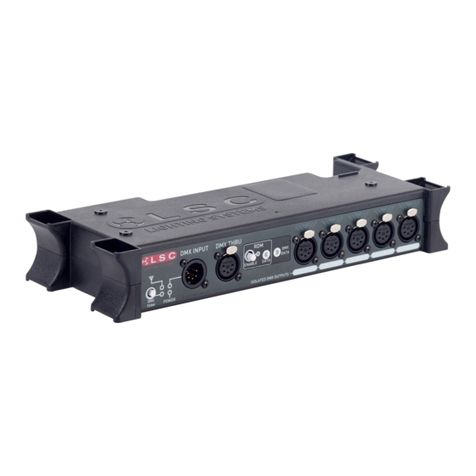Page 9
Unlike DMX512-A, RDM is bidirectional. This means that outgoing messages can be responded
to and reported back to the originator. This can allow RDM controllers to interrogate, control and
report on any RDM-enabled devices on the network. RDM can be used to:
•Change DMX start addresses
•Report faults
•Change fixture mode settings
•Request a list of fade curves available from a dimmer rack
•Report on lamp hours usage per fixture
•Report on the temperature of dimmers and other connected devices
RDM allows a lighting console to discover all the devices connected to its outputs and even how
many DMX slots each item requires. This information could then be used to auto-patch the entire
rig. The user settings of all the devices could be saved as part of the show file, so that when the
show is reloaded into the console, the system could ensure that all devices are still connected
and working, then checkthat the Pan invert settings andcustom dimmer curves on certain devices
have not changed. In the case of a faulty moving light, a new light could be connected and the
user settings (for example, DMX address, mode, tilt invert) automatically uploaded to the new
unit.
RDM is backwards compatible with existing DMX512 equipment, allowing non-RDM devices to
be connected to the same cable as RDM devices. The non-RDM units, if fully conforming to the
DMX512-A standard, will simply ignore all the RDM data. The only exception to the rule is
DMX512-A data splitters. Non-RDM units will simply block (stop) all RDM data from any devices
connected downstream of the DMX512-A splitter. Therefore, any lighting system using RDM must
use RDM-enabled DMX512-A data splitters.
4Wireless DMX512 Operation
Note: This option is no longer supported or supplied by LSC. This information is only supplied for
earlier MDR splitters that were fitted with this option.
For full wireless DMX512-A operation, please refer the manufacturer’s websites:
Wireless Solutions (W-DMX) www.wirelessdmx.com
City Theatrical (SHoW DMX) www.citytheatrical.com
The wireless DMX512 modules supplied by LSC for the MDR range of splitters are modified
receiver boards from the manufacturers listed above.
LSC do not supply wireless DMX512 transmitters. Please contact the above manufacturers for
the appropriate transmitter to work with the MDR splitter.
The wireless DMX512 module can work as a sole DMX512-A input source for the splitter or as a
backup source to the cable input, thus providing full redundancy for the DMX512-A cable input. If
both wireless DMX512 and cable DMX512 are receiving data, the cable DMX512 input has
priority. However, if there is a failure on the cable DMX512 input, the MDR splitter has an auto-
switching feature that seamlessly switches the input priority to the Wireless input. When the failure
on the cable DMX512 input has been rectified, the MDR splitter will automatically switch back to
the cable DMX512 input.
1. Connect Power, input (if required), thru (if required) and outputs as per the DMX512
section above.
2. For Wireless Solutions W-DMX models, press and release the Function button to
synchronise the receiver to the transmitter device. This process may take up to 10
seconds to synchronise. Once synchronised the Status indicator will illuminate.
3. To unlink the receiver from the transmitter, press and hold the Function button until the
Status indicator goes off. The receiver is now not linked to the transmitter.
4. For City Theatrical SHoW DMX models, there are two buttons, a display and a Status
indicator. The display shows four menu choices, various settings, and unit information.




























